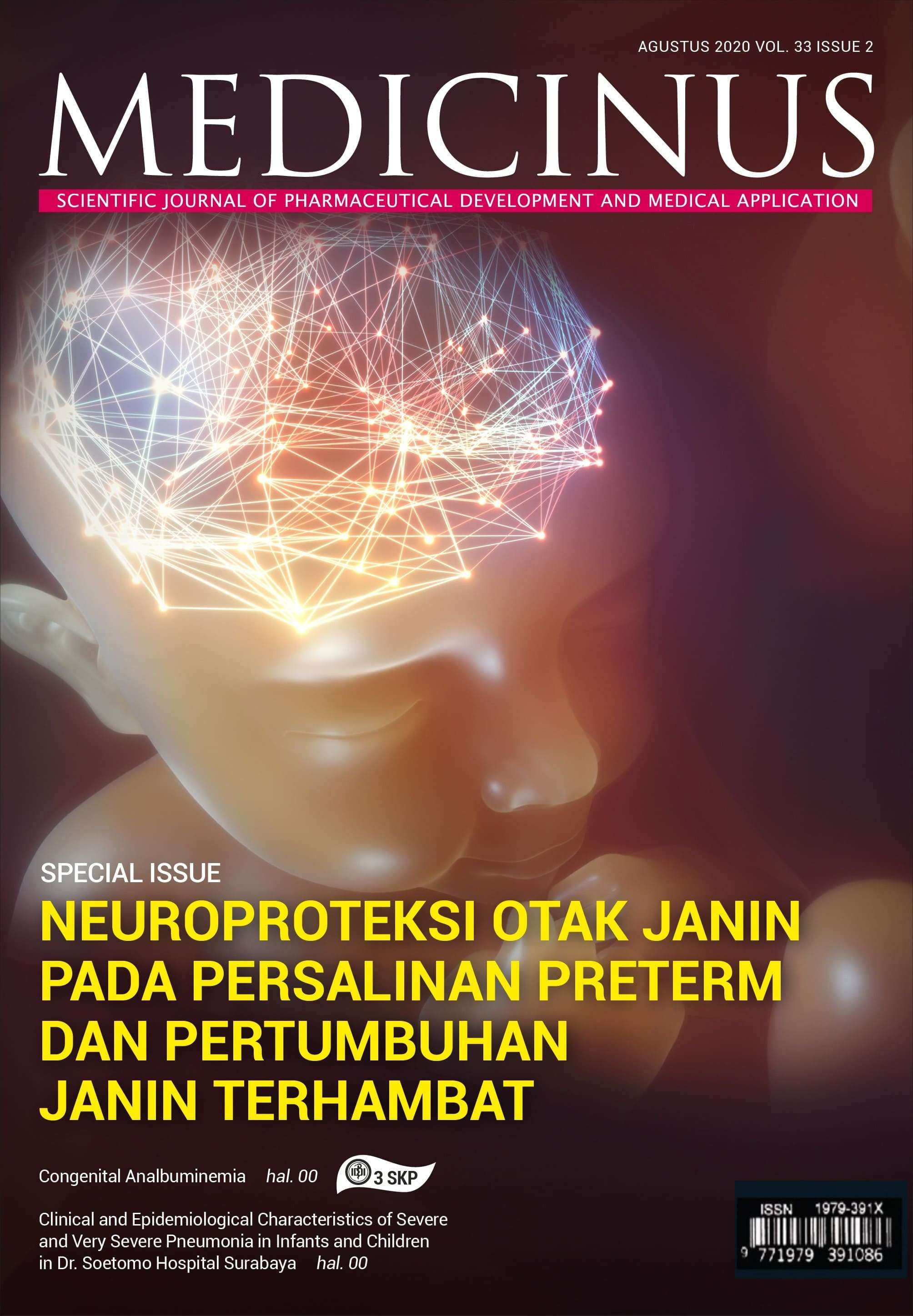Serum Level of 25-Hydroxyvitamin D in Children with Epilepsy Receiving Long-Term Antiepileptic Treatment
DOI:
https://doi.org/10.56951/medicinus.v33i2.59Kata Kunci:
epilepsy, antiepileptic drugs, 25-hydroxyvitamin DAbstrak
Background: Long-term treatment with antiepileptic drugs (AED) requires monitoring of potential side effects, one of them is the decreasing in serum vitamin D level. Low serum vitamin D level is also a global health problem in healthy children. There are conflicting results regarding the low serum vitamin D level in epileptic children due to treatment with AED. Purpose: This study aimed to compare serum vitamin D level between healthy children and children with epilepsy receiving long-term AED treatment in Soetomo General Hospital. Methods: This was a cross-sectional study conducted in the pediatric neurology clinic of Soetomo general academic hospital from August 2018 to July 2019. Subjects are children ages 2–18 years with epilepsy receiving AED treatment for over 6 months (n=22), with healthy children as control (n=22). Peripheral serum 25-hydroxyvitamin D level were measured using enzyme-linked fluorescence assay (ELFA) method. The differences of those groups were analyzed by comparing the mean of 25-hydroxyvitamin D level of both groups using Anova and T-test (95% CI). Results: Low serum vitamin D level were identified in 27% children with epilepsy and 13% healthy children. The mean of serum 25-hydroxyvitamin D level in children with epilepsy and healthy children was 21.5 ng/ml (SD 8.41) and 34.3 ng/ml (SD 10.09), respectively. There was a significant difference between groups (p<0.05). Conclusion: Children with epilepsy receiving long-term AED treatment have lower level of serum 25-hydroxyvitamin D than healthy children.
Keywords: epilepsy, antiepileptic drugs, 25-hydroxyvitamin D.
Unduhan
Referensi
Andrianti PT, Gunawan PI, Hoesin F. Profile of Epilepsy in Children and its Treatment Result in Dr Soetomo General Hospital. Sari Pediatri. 2016;18:34-9. DOI: https://doi.org/10.14238/sp18.1.2016.34-39
Harivenkatesh N, Haribalaji N, David DC, Kumar CP. Therapeutic Drug Monitoring of Antiepileptic Drugs in a Tertiary Care Hospital in India. Clin Neuropharmacol. 2015;38:1–5. DOI: https://doi.org/10.1097/WNF.0000000000000057
Fong CY, Riney CJ. Vitamin D Deficiency Among Children with Epilepsy in South Queensland. J Child Neurol. 2014;29:368–73. DOI: https://doi.org/10.1177/0883073812472256
Jones G. Extrarenal Vitamin D Activation and Interactions Between Vitamin D2, Vitamin D3, and Vitamin D Analogs. Annu Rev Nutr. 2013;33:23–44. DOI: https://doi.org/10.1146/annurev-nutr-071812-161203
Misra A, Aggarwal A, Singh O, Sharma S. Effect of Carbamazepine Therapy on Vitamin D and Parathormone in Epileptic Children. Pediatr Neurol. 2010;43:320–4. DOI: https://doi.org/10.1016/j.pediatrneurol.2010.05.013
Millward DJ. Nutrition, Infection and Stunting: The Roles of Deficiencies of Individual Nutrients and Foods, and of Inflammation, as Determinants of Reduced Linear Growth of Children. Nutr Res Rev. 2017;1–23. DOI: https://doi.org/10.1017/S0954422416000238
Guo CY, Ronen GM, Atkinson SA. Long-Term Valproate and Lamotrigine Treatment May be a Marker for Reduced Growth and Bone Mass in Children with Epilepsy. Epilepsia. 2001;42:1141–7. DOI: https://doi.org/10.1046/j.1528-1157.2001.416800.x
Bullinger M, Quitmann J, Power M, Herdman M, Mimoun E, DeBusk K, et al. Assessing The Quality of Life of Health-Referred Children and Adolescents with Short Stature: Development and Psychometric Testing of The QoLISSY Instrument. Health Qual Life Outcomes. 2013;11:76. DOI: https://doi.org/10.1186/1477-7525-11-76
Valentina V, Sri N, Andarwulan N. Asupan Kalsium Dan Vitamin D Pada Anak Indonesia Usia 2 – 12 Tahun. Jurnal Teknologi dan Industri Pangan. 2014;25:83–9. DOI: https://doi.org/10.6066/jtip.2014.25.1.83
Babayigit A, Dirik E, Bober E, et al., 2006. Adverse Effects of Antiepileptic Drugs on Bone Mineral Density, Pediatr. Neurol.; vol. 35, no 04: pp.177–81. DOI: https://doi.org/10.1016/j.pediatrneurol.2006.03.004
Xin-He, Jiang P, Zhu W, Xue Y, Li H, Dang R, et al. Effect of Antiepileptic Therapy on Serum 25(OH)D3 and 24,25(OH)2D3 Level in Epileptic Children. Ann Nutr Metab. 2016;68:119–27. DOI: https://doi.org/10.1159/000443535
Robien K, Oppeneer SJ, Kelly JA, Hamilton-Reeves JM. Drug–Vitamin D Interactions. Nutr Clin Pract. 2013;28:194–208. DOI: https://doi.org/10.1177/0884533612467824
Unduhan
Terbitan
Bagian
Diterbitkan
Unduhan
Lisensi
Hak Cipta (c) 2020 Chasan Ismail, Roedi Irawan, Darto Saharso

Artikel ini berlisensi Creative Commons Attribution-NonCommercial 4.0 International License.




